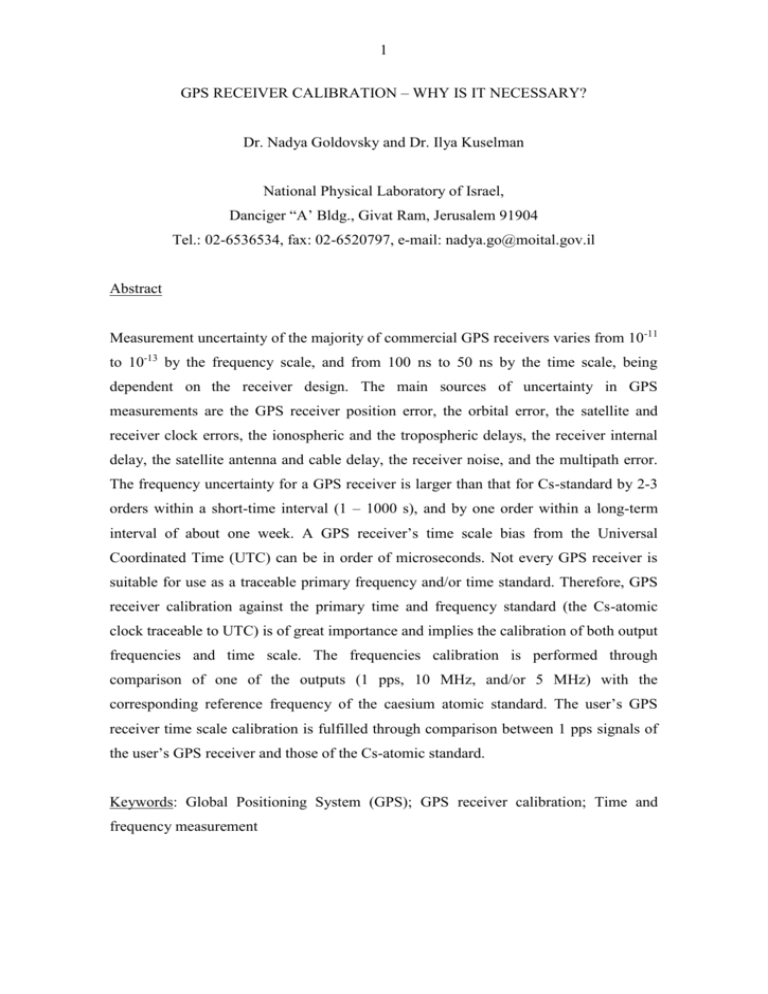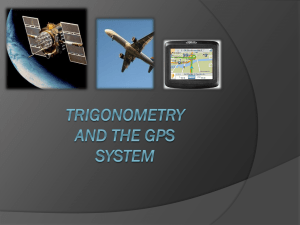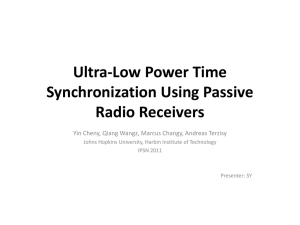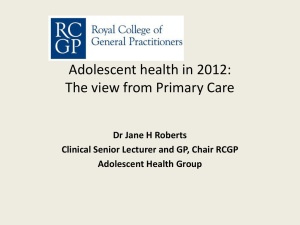GPS receivers Calibration at INPL
advertisement

1 GPS RECEIVER CALIBRATION – WHY IS IT NECESSARY? Dr. Nadya Goldovsky and Dr. Ilya Kuselman National Physical Laboratory of Israel, Danciger “A’ Bldg., Givat Ram, Jerusalem 91904 Tel.: 02-6536534, fax: 02-6520797, e-mail: nadya.go@moital.gov.il Abstract Measurement uncertainty of the majority of commercial GPS receivers varies from 10-11 to 10-13 by the frequency scale, and from 100 ns to 50 ns by the time scale, being dependent on the receiver design. The main sources of uncertainty in GPS measurements are the GPS receiver position error, the orbital error, the satellite and receiver clock errors, the ionospheric and the tropospheric delays, the receiver internal delay, the satellite antenna and cable delay, the receiver noise, and the multipath error. The frequency uncertainty for a GPS receiver is larger than that for Cs-standard by 2-3 orders within a short-time interval (1 – 1000 s), and by one order within a long-term interval of about one week. A GPS receiver’s time scale bias from the Universal Coordinated Time (UTC) can be in order of microseconds. Not every GPS receiver is suitable for use as a traceable primary frequency and/or time standard. Therefore, GPS receiver calibration against the primary time and frequency standard (the Cs-atomic clock traceable to UTC) is of great importance and implies the calibration of both output frequencies and time scale. The frequencies calibration is performed through comparison of one of the outputs (1 pps, 10 MHz, and/or 5 MHz) with the corresponding reference frequency of the caesium atomic standard. The user’s GPS receiver time scale calibration is fulfilled through comparison between 1 pps signals of the user’s GPS receiver and those of the Cs-atomic standard. Keywords: Global Positioning System (GPS); GPS receiver calibration; Time and frequency measurement 2 Introduction Global Positioning System (GPS) is well known as a tool for both positioning and for high accuracy time and frequency transfer. Hundreds of companies sell GPS products, and many of manufacturers advertise their units as being time and frequency standards. The characteristics of a GPS receiver depend on the applications for which it was designed. There are two main types of GPS receivers: commercial GPS receivers intended for navigation (for example, in commercial and military aircraft, marine and automobile navigation) [1], and GPS receivers used in time and frequency metrology [2]. Commercial GPS receivers intended for navigation provide X,Y,Z coordinates of their location. Receivers used in cars are generally intended for driver navigation or for sending information on the location of a car to an emergency response center in case of accident. Receivers intended for commercial airliners have usually a data port for integration into the air navigation systems. The required uncertainty of such receivers is of the order of 1 – 100 m [1]. GPS timing receivers provide a 1 pulse per second (1 pps) electrical output. Most receivers use the coarse acquisition (C/A) code broadcast on the frequency of 1.57542 GHz (L1) as their time and frequency reference. The 1 pps output can provide time synchronization at locations anywhere on earth, or provide the timing reference for either a telecommunications network or for an Internet timeserver. Another type of GPS receivers known as GPS disciplined oscillators [3], provide standard frequencies of 5 MHz and/or 10 MHz, and sometimes produce frequencies of 1.544 MHz or 2.048 MHz used in telecommunications. Digital telecommunication networks that carry voice, data, and facsimile information require a reference frequency source with an uncertainty of 10-11 or less [2,4] for ensuring quality-of-service to the clients. Two other types of GPS receivers used for more precise measurements are commonview GPS receivers and carrier-phase GPS receivers [2]. A common-view GPS receiver is actually integrated system that combines a standard GPS timing receiver with 3 measurement hardware and software. These hardware and software allow the system to make measurements from individual satellites and to store the measurement results that can be processed later. Carrier-phase GPS receivers are designed for geodetic and surveying applications. Usually more expensive than the traditional time and frequency receivers, they track and measure the precision (P) code broadcast on two carrier frequencies L1 and L2 (the last one is at 1.2276 GHz). Their potential positioning performance is exceptional, the positioning uncertainty being within centimeters or even millimeters ranges [2]. Common-view and carrier-phase measurements require more effort, including postprocessing of the measurement data. For this reasons, they are usually used in international time and frequency comparisons between National Metrology Institutes (NMI) [2]. Although GPS broadcasts are continuously monitored by National Institute of Standards and Technology (NIST), USA, not all GPS receivers are suitable for use as traceable primary frequency standards. The importance of the GPS receiver calibration, as well as the calibration method used in the National Physical Laboratory of Israel (INPL) are discussed in the present paper. The importance of GPS receiver calibration While GPSs differ significantly, there are two common key factors that contribute to a GPS receiver performance, namely, the quality of the receiver’s internal oscillator and the quality of the software algorithm that processes data obtained from satellites [3]. The majority of GPS receivers have frequency short-term stability of about 10-10 – 10-11 [2]. Models with the best short-term stability discipline an oven-controlled quartz oscillator or a rubidium oscillator to the GPS signal. However, even GPS receivers of this type have a short-term stability that is lower than the Cs-standard stability. Such standard is maintained, for example, at INPL [5-8]. 4 Many receivers do not discipline an oscillator at all. Instead, they divide the output of a small temperature-controlled crystal oscillator down to 1pps, and then synchronize 1 pps with GPS signal. As a result, the short-term stability of these models is poor (the frequency uncertainty is about 10-9 – 10-10 over the averaging time about 1 –1000 s [2,3]). Most GPS receivers automatically select satellites used for the timing solution. However, software algorithms used to select satellites are different, and each receiver has its own thresholds at which it chooses to keep or to omit a satellite. Some algorithms limit the timing solution to just one, or to a few satellites. Others can use as many as 12 satellites in a solution. For this reason, two GPS receivers can yield different results even when connected to the same antenna at the same location. Since each GPS satellite is visible at a given location for a limited time, all GPS receivers must add and remove satellites from the group used to obtain time and frequency information. Often, adding and/or removing a satellite from the timing solution causes an instantaneous frequency change. Various receivers handle GPS broadcast errors differently. Some receivers have built-in software designed to remove “bad” data, other have no such software. But all GPS receivers might bias their time scale or even fail under certain conditions, namely, strong ionospheric disturbances (for example, ionospheric scintillations). Different types of GPS receivers are applied in different types of GPS measurements. These measurements in the field of time and frequency metrology can be divided into four general categories: one-way, common-view, carrier-phase, and two-way satellite time and frequency transfer (TWSTFT) [3]. The majority of user GPS measurements are one-way measurements. The one-way GPS technique uses the signals, obtained from a GPS receiver, as the reference for a calibration. The purpose of the measurement is either to synchronize an on-time pulse, or to calibrate a frequency source. The GPS signal is used in real time, and no post processing of the measurement results is required. 5 The main error sources in one-way GPS measurements are expressed by the basic equation for pseudorange [9]: p = ρ+dρ+c(dt-dT)+dIon+dTrop+ερ+ρmult , (1) where p is the measured pseudorange; ρ is the calculated geometric range between satellite and receiver ( i.e. [(XS-XR)2+(YS-YR)2+(ZS-ZR)2]1/2 ); XS,YS,ZS and XR,YR,ZR are the coordinates of the satellite and the receiver, respectively; dρ is the orbital error; dt and dT are the satellite and the receiver clock errors, respectively; d Ion is the ionospheric delay; dTrop is the tropospheric delay; ερ is the receiver code noise; ρmult is the multipath error [10]. Common-view, carrier-phase, and TWSTFT measurements are more precise measurements and require post-processing of the measurement data. The collected data are analyzed and processed using precise satellite orbit information and detailed models of the ionosphere and troposphere. These types of GPS measurements are usually used for international time and frequency comparisons between NMI. In common-view time transfer the time difference between two clocks is determined by simultaneous observation of the same satellite at the same time in two different laboratories. The measurement results are then exchanged and the difference between two time scales is obtained. This technique gives improved performance over the oneway technique. It eliminates satellite clock errors, and reduces orbital errors, ionospheric and tropospheric errors [3]. By forming the double and triple difference [3] using two and more satellite observations, the receiver clock errors also can be eliminated. The accuracy of common-view time transfer is typically in the 1 to 10 ns range. The GPS common-view technique has been used for many years by the Bureau International des Poids et Mesures (BIPM) as one of its main techniques for international time comparisons. The TWSTFT technique eliminates nearly all of the propagation delay errors because the signal path symmetry for both stations [3]. Recently BIPM has started using twoway technique as a primary time transfer technique. The uncertainty of TWSTFT over a 6 24 hours period is better than 1 ns and has been be as low as 100 picoseconds in some systems [3]. The traceability requirements for time and frequency measurement According to [11], the metrological traceability is “the property of a measurement result relating the result to a stated metrological reference through an unbroken chain of calibrations of a measuring system or comparisons each contributing to the stated measurement uncertainty”. The traceability chain for measurements in field of time and frequency is shown in Fig.1 [4]. The traceability chain is beginning from a measurement instrument, for example, a time interval counter. Link A is the link between the measurement instrument and the user’s GPS receiver. Measurement uncertainty sources in link A are: user’s GPS receiver uncertainty, multipath error [10], satellite clock error, uncertainty of the time delay in atmosphere, errors in satellites orbit calculation, uncertainty of calibration procedures, and human errors. The uncertainty of the user’s GPS receiver is caused by receiver’s noise, the internal oscillator’s instability, software error, uncertainty of time delay in antenna, in antenna’s cable, and finally GPS receiver internal delay. GPS receiver calibration is carried out in order to determine: 1) frequency deviation from its nominal value and uncertainty of this deviation; 2) the GPS receiver second bias from the SI second; 3) the GPS receiver time scale deviation from the Universal Coordinated Time. The deviation of the GPS receiver time scale from UTC can be relatively large (several microseconds) and is dependent on the time delays in the GPS receiver, in GPS’s antenna and in antenna’s cable; on the error of atmospheric delay calculation, and other software errors. Therefore, the calibration of GPS receiver against the time and frequency standard (the Cs-atomic clock traceable to UTC and SI second) is of great importance. It should be noted that UTC is a “paper” theoretic time scale calculated by BIPM in Paris. The time signals received by user’s GPS are referenced to real time scale called GPS time. The GPS system includes a constellation of 24 satellites [2]. The GPS satellites are controlled and operated by the United States Department of Defense. Each satellite 7 carries either rubidium or caesium oscillators, or a combination of both. The on-board oscillators provide the reference GPS time for transmission. The relation between GPS time and UTC involves a variable number of seconds as a consequence of the leap seconds and is as follows: [UTC – GPS time] = -13 s + C0 (2) where C0 is the correction given in the BIPM monthly Circular-T at 0h UTC. The C0 values vary in the range of ± 20 ns, and their expanded uncertainty is in the range of ±10 ns [12]. Link B connects the user’s GPS receiver to the broadcast signal monitored by NMI. Measurement uncertainty in this link is caused by the signal path from the GPS satellite to GPS receiver’s antenna. This uncertainty consists of tropospheric delay error, ionospheric delay error, orbital errors, and multipath errors. There are several agencies that provide calculation of satellite orbit, ionospheric delay, and tropospheric delay, for example, the Center for Orbit Determination in Europe and the International GPS Service. Among the error sources mentioned above, the major uncertainty is caused by tropospheric and ionospheric delay, which can reach to several hundreds of ns for low elevation angle satellites. Link C is the control, or monitoring, link between an NMI (for example, INPL) and the broadcast service. Link C connects the NMI to GPS satellite system. This link is established through the NMI’s measurements of the GPS signals. Link D is the chain between the UTC scale and the local Coordinated Time Scale UTC(NMI) maintained by the NMI. UTC is calculated by averaging of data collected from more than 200 atomic clocks located in about 50 national laboratories spread worldwide and regularly reported to BIPM. The uncertainty of link D can be evaluated using BIPM’s Circular T. The SI second is defined as the duration of 9,192,631,770 periods of the radiation corresponding to the transition between the two hyperfine levels of the ground state of the caesium 133 atom. Frequency (expressed in hertz) is derived from a second and 8 equals to the number of events over a 1-second interval. Thus, GPS receiver cannot be used as primary frequency and time standard, it can be used as secondary frequency and time standard only. As for every traceability chain, the measurement uncertainty in the chain shown in Fig. 1 is increasing in the direction opposite to traceability, i.e. from link D to link A. User’s GPS receiver frequency calibration at INPL Results of measurements and calibrations in field of time and frequency in Israel are traceable to the National Standard of Time and Frequency and the UTC(INPL) scale maintained by INPL, according to the law on the National Israel Time Scale since 1992. Once traceability to INPL is established, it is accepted as well in other countries that signed the mutual recognition arrangement [13]. In order to show traceability of a GPS receiver to UTC(INPL), an unbroken chain must be established between the measurements made by GPS receiver at the user’s site and the UTC(INPL) time scale. The block diagram of the GPS receiver calibration system used at INPL is shown in Fig. 2. The calibration system comprises: Cs-Standard traceable to UTC via GPS commonview link; the unit under test (UUT), for example, user’s GPS receiver; a time interval counter; a pulse distribution amplifier; a 1 pps generator (optionally, when UUT does not have its own 1 pps output); a personal computer (PC1) for GPS time transfer data processing; a INPL GPS receiver applied for common-view measurements; a satellite antenna; a microprocessor with time interval counter; a monitor; a printer; an ionospheric calibration receiver (ICR) with a satellite antenna; a commutation switch box; a personal computer (PC2) for calibration data processing; a high frequency (5 MHz) signal distribution amplifier [14, 15]. The GPS receiver calibration implies the calibration of output frequencies and the calibration of time scale. The frequencies calibration is performed through comparison of one of the outputs (1 pps, 10 MHz and/or 5 MHz) with the corresponding reference frequency of the INPL caesium atomic standard. The time interval counter measures the 9 time differences between calibrated and reference signals. UTC(INPL) calculation is developed in [5-8]. The frequency calibration procedure and the procedure for comparisons between UTC(INPL) and UTC are described in detail in [14, 15]. Frequency standards and oscillators stability is described by the fractional frequency deviation and Allan variance [16-18]. The fractional frequency deviation is: y=(fUUT–fREF)/fREF, (3) where fUUT is the calibrated frequency of the UUT; fREF is the reference frequency of the Cs-Standard. Allan variance σy2(τ) is: N-1 N-1 σy2(τ)=(1/2) · (N–1)-1·∑(yk+1-yk)2=(1/2) · (N-1)-1τ-2 ∑(xk–2xk+1+xk+2)2, k=1 (4) k=1 where N is the number of measurements; x is the difference between signals of the UUT and the reference clock; τ is the averaging time (the time between two successive x measurements). The square root from the variance σy2(τ) is the Allan deviation σy(τ). The y of the calibrated GPS receiver over all the measurement time is defined as the slope of the linear regression fit for the time comparison results between UUT (a GPS receiver) and the reference Cs-Standard. The number of measurements N of time differences x between the UUT and the reference Cs-Standard is about 20 000 – 32 000. To determine the metrological characteristics of the calibrated GPS receiver relatively to UTC, the reference frequency yREF and its uncertainty UREF should be taken into account. Thus, the corrected value of the UUT frequency yUUT-UTC and its uncertainty UUUT-UTC are calculated by the following equations: y[UUT-UTC] = y[UUT-INPL] + yREF , (5) 10 where y[UUT-INPL] is the fractional frequency deviation of the UUT relatively to INPL reference frequency; yREF = y[INPL-UTC] is the fractional frequency deviation of the INPL reference frequency relatively to UTC frequency, computed from the last BIPM Circular T. The expanded uncertainty of the calibrated GPS receiver frequency is: UUUT-UTC = k ( u2UUT-INPL + u2REF )1/2 , (6) where k is the coverage factor (k=2 for 95% confidence level in case the number of degrees of freedom N-1 is larger than 20 000); uUUT-INPL is the standard uncertainty of the calibrated GPS receiver frequency relatively to the INPL reference; uREF is the standard uncertainty of the INPL reference frequency yREF relatively to UTC, computed from BIPM Circular T for the minimal τ. The expanded uncertainty of the INPL reference frequency is: UREF = k σy(τ) / √ N (7) The expanded uncertainty of the INPL caesium atomic standard is about 10-14 over one week averaging, while the uncertainty of user’s GPS receivers relatively to INPL frequency reference uUUT-INPL is about 10-13 – 10-11. User’s GPS receiver time scale calibration at INPL The calibration of user’s GPS receiver time scale is performed at INPL according to the block diagram shown in Fig. 2. The measurements are performed simultaneously in two parallel channels. In the first channel, the user’s GPS receiver time scale is compared with the UTC(INPL). For this purpose, the 1-second signals (1 pulse per second) of the user’s GPS receiver and the INPL Cs-Standard are compared by the time interval counter. The obtained difference between UTC(INPL) and UUT time scales is D1 = UTC(INPL) – UUT time. Connecting cables delay is subtracted from the difference in the D1 value calculation. In the second channel, the international comparisons between the local and GPS time scales are performed by the INPL GPS receiver operating in the common-view mode. The obtained difference between UTC(INPL) and GPS time scales is D2 = UTC(INPL) – GPS time. These comparisons are performed continuously, and their results are 11 reported to BIPM once a week. The time delays in the INPL GPS receiver, its antenna, antenna’s cables, and connecting cables are known with the uncertainty of ± 1 ns. Moreover, the corrections for ionospheric and tropospheric delays are also taken into account at the D2 value calculation [15]. The obtained values of D1 contain the time delay in the user’s GPS receiver, in its satellite antenna, in antenna’s cable, as well as the bias caused by user’s software errors. These factors lead to a deviation of the user’s GPS time scale (UUT time) from the universal GPS time D3 = GPS time – UUT time. Determination of the D3 value can be made by subtracting the difference D2 from the difference D1: D3 = D1 – D2 (8) For this purpose, D1 and D2 should be obtained for the same real time, in other words, the measurements in both channels should be performed simultaneously from the same beginning time point and for the same calibration time. Then the D1 and D2 values obtained are fitted by two linear regressions. The D3 value is calculated as the mean difference between these two linear regressions. An example of such fitting is shown in Fig. 3. Here the mean D3 value is 1.27 microsecond. The user’s GPS receiver time scale deviation from UTC is calculated by adding [UTC – GPS time] correction from Circular T to D3 value: UTC – UUT time = D3 + [UTC – GPS time] (9) The uncertainty of the user’s GPS receiver time scale deviation from the GPS time scale is: UD3 = k (u2D1 + u2D2 + u2C + u2L)1/2 , (10) where uD1 is the standard uncertainty of linear regression fit for D1; uD2 is the standard uncertainty of linear regression fit for D2; uC is the standard uncertainty of the connecting cable delay; uL is the standard uncertainty of the INPL GPS receiver’s delay, antenna’s delay, and antenna’s cable delay; k=2 is the coverage factor. 12 As a rule, the dominant contribution of the expanded uncertainty (10) is caused by a residual deviation of the user’s GPS receiver scale from a straight line, which is uD1 > 20 ns. For comparison, in the case in Fig. 3, uD2 is about 5 ns, uC and uL are about 1 ns each. Therefore, UD3 = 41 ns here. Conclusions Due to performance differences, two user’s GPS receivers can yield different frequency results even when connected to the same antenna at the same location. The frequency uncertainty for user’s GPS receiver is larger than that for Cs-standard by 2-3 orders for a short-time interval (1 – 1000 s), and by one order for a long-term interval of about two weeks. The user’s GPS receiver time scale bias from the Universal Coordinated Time can be in order of microseconds. It depends on the time delay in GPS receiver, satellite antenna, antenna’s cable, ionospheric correction error, and software errors. Commercial GPS receiver calibration service provided by INPL ensure measurement uncertainty of about 10-14 in the frequency scale, of about 5 ns in the time scale, as well as traceability to the Universal Coordinated Time. References [1] http://www.colorado.edu/geography/gcraft/notes/gps/gps_f.html Cited 27.12.04 [2] M.A.Lombardi, L.M.Nelson, A.N.Novick, V.S.Zhang, Time and Frequency Measurements Using the Global Positioning System, Cal. Lab. (Int. Jour. of Metrology), July-September 2001, pp. 26-33. [3] http://www.boulder.nist.gov/timefreq/service/gpscal.htm Cited 27.12.04 [4] M.A.Lombardi, Traceability in Time and Frequency Metrology, Cal. Lab. (Int. Jour. of Metrology), September-October 1999, pp. 33-40. [5] A.Lepek, A.Shenhar and D.W. Allan, UTC(INPL) – a virtual time scale, Metrologia, 1995/96, 32, pp. 245-252. [6] A.Lepek, A.Shenhar, M.Bezalel, The UTC(INPL) time scale, Proceedings of Ninth International Conference of the ISQA, 1992, pp. 502-506. 13 [7] A.Lepek, Atomic scale based on optimum linear prediction, IEEE Frequency Control Symposium, 1997, pp.382-387. [8] A.Lepek, Clock prediction and characterization, Metrologia, 1997, 34, pp.379-386. [9] http://www.geomatics.ucalgary.co/links/GradTheses.html Cited 27.12.04 [10] J.Ray, Mitigation of GPS code and carrier phase multipath effects using a multiantenna system, Ph.D. Thesis, Department of Geomatics Engineering, University of Calgary, Canada, 2000. [11] International Vocabulary of Basic and General Terms in Metrology, ISO, Geneva, 2004. [12] http://www.bipm.fr Cited 27.12.04 [13] Mutual Recognition of National Measurement Standards and of Calibration and Measurement Certificates Issued by National Metrology Institutes, BIPM, Paris, 1999. [14] N.Goldovsky, M.Luria, Frequency Standard and Oscillators Calibration at the National Physical Laboratory of Israel, Proceedings of the 14-th International Conference on the Israel Society for Quality, Jerusalem, November 2002, pp. 394399. [15] N.Goldovsky, M.Luria, Ionospheric delay contribution to the uncertainty of time and frequency measurement by one-way satellite time transfer method, Measurement, 35, 2004, pp. 353-362. [16] D.W.Allan, Statistics of Atomic Frequency Standards, Proc. IEEE, vol. 54, February 1966, pp. 221-230. [17] D.W.Allan, The Measurement of Frequency and Frequency Stability of Precision Oscillators, NBS Tech. Note 669, July 1975. [18] F.L.Walls and D.W.Allan, Measurements of Frequency Stability, Proc. of the IEEE, vol. 74, №1, January 1986, pp. 162-168. 14 UTC and SI Second (BIPM) D UTC(NMI) C Broadcast GPS signal monitored by NMI B User’s GPS receiver A Measurement instrument Fig. 1. The traceability chain for time and frequency measurements. 15 Monitor Printer Commutator Distrib Ampl. Microprocessor 5 MHz GPS Pulse Distrib Ampl. 1 pps start 1 pps stop 5 MHz 5 MHz 1 pps 5 MHz ICR INPL GPS Receiver 1 pps Cs-Standard PC1 5 MHz ICR 1 pps 5 MHz Time Interval Counter PC2 start UUT GPS Receiver stop 1 pps Generator (Optionally) Fig. 2. Block diagram of GPS receiver calibration system. 16 12.000 11.800 Microsecond 11.600 11.400 D1 = UTC (INPL) - UUT time 11.200 D2 = UTC (INPL) - GPS time 11.000 10.800 10.600 10.400 0 1 2 3 4 5 6 Days Fig. 3. The time difference D3 between the user’s GPS receiver and the GPS time scales.









